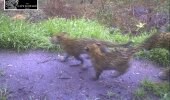Words: Bridgestone South Africa
Surveys of wild animals killed by passing traffic (roadkill) have produced strong data and several recommendations. This is according to Bridgestone, which sponsored the Endangered Wildlife Trust's (EWT) recent investigations into the issue of roadkill in the Pilanesberg National Park.
Courtesy of: Bridgestone South Africa
The surveys, conducted by the EWT between 21 October and 23 November 2014, consisted of on-site investigation of roadkill as well as questionnaires completed by 302 visitors to the park. Of the 120 roadkill observed by the roadkill research team, 62 were amphibians, 27 were reptiles, 20 were birds, ten were mammals and one was not identifiable.
Vehicle numbers were monitored by the use of traffic counting devices. However, the roadkill research team soon discovered that elephants had taken a liking to the devices and damaged them. Drawing on previous research which has shown that elephants dislike the smell of chilli pepper, the team then applied a daily coating of chilli pepper and oil onto the counters. The traffic counting devices were then protected from further damage.
One of the most interesting aspects of the project was the role of speed in contributing to roadkill. “More than 95% of respondents to the questionnaire survey believe that speed is the sole cause of roadkill. Our aim was to investigate this issue in more detail,” said the EWT's Wildlife and Roads Project Executant, Wendy Collinson.
Compliance with park speed limits was found to be high, with 72% of the 6981 vehicles monitored driving at or below the speed limits. In order to investigate the role of speed in determining rates of roadkill, the research team placed fake animals on the road and observed the behaviour of 201 drivers. “Of these drivers, almost 70% were considered to not be looking at the road, but rather scanning the bush for wildlife”, said Collinson. “This suggests that many roadkills in national parks happen because of the expectation that animals are to be found in the habitat alongside the road, rather than on the road itself”, she added.
The team did not find a significant relationship between the number of fake animals hit and the speed at which the vehicles were travelling, with 71.5% of drivers driving over the animals when assessed to be driving less than 20 km/h, 62.1% when driving between 20-40 km/h, and 74.2% driving more than 60 km/h.
“From our survey, it seems that observation levels of the driver, rather than the speed of the vehicle, is the key factor in preventing roadkills,” Collinson commented. “One of our recommendations from the latest roadkill survey is that a driver awareness campaign be launched in parks to make drivers more aware of animals on the roads themselves,” Collinson commented.
Collinson also said she was concerned about the low awareness levels of roadkills among park visitors. “Of the 284 respondents who had visited a park previously, only 2.8% had noticed roadkill, with 6.3% noticing a roadkill on their current visit,” she explained.
Bridgestone PR Manager, Desirée van Niekerk, said the results of the latest roadkill survey had proved as fascinating as ever. “Bridgestone has been involved with the roadkill project for three years now, and we applaud Wendy and her team's contribution to both road safety and wildlife protection,” she said. “We hope these latest findings will soon be used to improve the quality of the experience of park visitors and safeguard the animals in these protected areas,” she concluded.
The next stage of the project will shortly commence in Addo Elephant National Park.
More information: www.bridgestone.co.za and www.ewt.org.za











